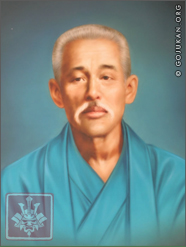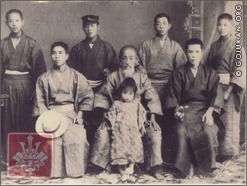Kanryo Higaonna
東恩納 寛量
Resources:
None at Present
Options:
Page is under Construction
_____

Kanryo Higa(shi)onna was born on March 10, 1853 in the district of Nishimura in the city of Naha,Okinawa.Son of Kanryo and Makomado. His father was a merchant trading food andclothes through the Ryukyu Islands. At the age of 10, Kanryo Higaonna Sensei started to work with his father, since his 2nd and 3rd brothers died at early age, and his 1st brother was weak and sick.
At the age of 14 he commenced his formal training in Chinese Kempo with Seisho Arakaki, who had studied the Fukien style. Unfortunately not too long after, his father died as the result of a fight. This shocked the young Higaonna so much that his thoughts were filled with a desire for revenge. This was when he decided to travel to China to learn the deadly martial arts to avenge his father’s death.
At that time, traveling to China was restricted only to merchants, students or government officials. Permission to travel was only granted by the King of Okinawa, and the only port of departure was the port of Naha.
Higaonna, with the help of the official Udon Yoshimura, obtained a permit to travel to Fuchow, China, as a student. He departed from the port of Naha in the year 1866, at the age of 15.
On his arrival in Fuchow, Higaonna was accepted in the Ryukyu Kan or lodge where all the students from Okinawa were living. After a year in residence he was introduced to the renowned martial arts instructor Ryu Ryu Ko (also known as Xie Zhongxiang). Ryu Ryu Ko Sensei earned his living making bamboo baskets, working from the ground floor of his house. At the time he taught martial arts to only to a small group of selected students.
Kanryo Higaonna was not permitted to train immediately, and had to follow the age-old custom of personal service to his master by attending the garden, cleaning and doing odd chores. After he had satisfied his master’s expectations, he was accepted as a disciple.
At first Kanryo Higaonna was instructed only in Sanchin kata. His motivation and dedication soon started to show, and as his skills progress he became a “uchi deshi” (live-in student). He moved out from the Ryukyu Kan and started to live and work at Ryu Ryu Ko’s bamboo shop. Training took place at night starting with the practice of Sanchin and was severe. He was introduced to the different traditional equipment such as chiishi (stone weights), ishi sashi (stone padlocks), nigiri game (gripping jars), tan (barbell) and muning (variation of makiwara).
The fame of Ryu Ryu Ko Sensei was widespread. He learned the martial arts in the southern Shaolin temple in the mountains of the Fujian Province. His teacher was a Court Official from the Dynasty. Ryu Ryu Ko Sensei also instructed Higaonna in the use of weapons such the Daito (long sword), Shuto (small sword), Sai and Bo. He also taught him herbal medicine. In few years Higaonna became Ryu Ryu Ko Sensei’s top student. Higaonna trained for 14 years in China. In 1881 he returned to Okinawa with the promise to his teacher than it would never abuse the skills he had learnt.

He settled back in the district of Nishimura in the City of Naha and like his father, in the past, became a merchant, traveling with his boat in between the islands of the Ryukyu chain. He began to teach a select group of students at his house. His instruction was very severe. In a short time he obtained the same good reputation that he had developed in Fuchow. It wasn’t too long before the King of Okinawa invited Kanryo Higaonna to teach him the martial arts.
In 1905 he was invited to teach his Naha-Te (Te from Naha) in the Naha Commercial School. The Principal wanted to teach the students the spiritual and moral aspects of the martial arts. This was an important breakthrough, not only for the recognition of the benefits of the practice but also because until then Te was taught as a martial art with the skill to kill.
After his research, Kanryo Higaonna, decided to make an important change in the Sanchin kata. Until then, Sanchin kata was practiced with open hands, so he started to teach it with close hands and slower breathing with the purpose of promoting the health benefits, rather than promoting lethal techniques at the school. Higaonna introduced the closed fist to emphasize the physical strength more than the ability to kill. Tradition also played an important role for this change because he noticed that a lot of young Okinawans, without any knowledge of martial arts, naturally stood with closed fists when they were going to fight. He continued to teach the original way that he learned in China to a few students at his Dōjō.
After 1905 Karate became a little more accessible to the general population. Up until then, Te was taught to a selected group of people.

Kanryo Higaonna Sensei passed away on 23rd December 1915 at the age of 62.